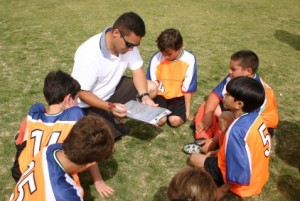
As a coach, teach young players the book-written tactics but also tell them to be themselves and develop their own style.
Ever play against a team in your middle school or kindergarten league who has one outstanding player that seems to be unstoppable? There’s a great way to neutralize a player like this and it’s through specialized marking.
One of the big differences between higher and lower levels of soccer is that the higher the level the harder the work needed to win the ball. A good defender will position himself in such a way that it makes life difficult for the attackers they are marking to take possession of the ball or make good passes. They will position themselves so that they can intercept or take possession of a ball successfully or block the path of an opponent to the goal at any moment of the game. It is this skill that you most develop to become an efficient marker.
Marking tactics might be obvious for higher level players and coaches, but for pee wee, preschool, or kindergarten age children the concept might be hard to grasp. As a coach, teach young players the book-written tactics but also tell them to be themselves and develop their own style. Marking is one of the easiest skills to demonstrate.
A defender should take up a position between the goal he is defending and that of the opponent he is marking. In this position you can attack the ball if it comes close, or run with your opponent should he suddenly move. This position will also limit the area into which the ball can be played to the marked player.
It is sometimes necessary to deviate from this general principle when marking a player who is a long way from the ball. Attackers moving in on near post balls from the wings will have to be marked so that the defender can get to the ball first. This will often mean marking more on a line with the near post.
Ideally you should mark close enough to the attacker so that you can intercept a loose pass by moving forward quickly. This distance between defender and attacker will vary depending on several factors. Speeds of both players will be a big factor. If you feel that you are faster than the man you’re marking, you can stand close to the attacker. If, on the other hand, the attacker is faster, it would be unwise to mark too closely. Instead, adopt a position from which you can tackle him as he is receiving the ball and have sufficient room to pick up his run should he move.
Another factor is the technical ability of the attacker. If he has excellent ball control, you should mark him tight in an attempt to harass him when he receives the ball. You can often allow more space for an inexperienced player and make him try to control the ball, knowing that he will make an error and you can take possession as the ball bounces away.
Generally speaking, the closer he is to your goal the tighter you must mark. Technically experienced players will only require a very limited space in which to be effective.
A simple aggressive soccer drill of defending a post will help you react to an attacker’s movement. Place the post in the middle of a circle about two yards in diameter. Stand in front of the post outside the circle with an attacker facing you. The object of the exercise is for the attacker to try to touch the post while the defender reacts to his movements and attempts to block his path. The attacker must be encouraged to deceive the defender by changing direction and feinting; bodily contact must be avoided.
As for teaching these tactics to young players in the 10 and under range, the key is to tell them, or show them through video, that it’s ok to take chances. This is a time when they should be learning and experimenting anyway. Soon they’ll learn more about themselves and the game and will be better able to judge how they should approach a given play. Introduce them to marking tactics and then let them be creative. You’ll be surprised how fast they’ll progress!


No comments yet.